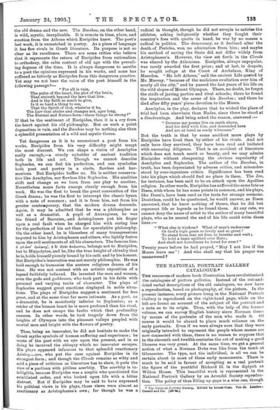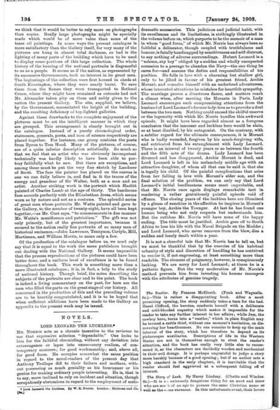THE NATIONAL PORTRAIT GALLERY CATALOGUE.* THE resources of modern book
illustration have revolutionised the catalogues of picture galleries. Instead of the cut-and- dried verbal descriptions of the old catalogues, we now have a reproduction, based on photography, of the picture. In the
present instance, every picture hung in the National Portrait Gallery is reproduced on. the right-hand page, while on the
left are found an account of the subject of the portrait and a note as to its origin. Thus, with the help of the former volume, we can survey English history since Norman times by means of the portraits of the men who made it. Of course it would be absurd to place much reliance on the early portraits. Even if we were always sure that they were originally intended to represent the people whose names are now connected with them, there is no reason to suppose that in the eleventh and twelfth centuries the art of making a good likeness was very great. At the same time, we get a general notion of what a Norman Duke was like from the tomb at Gloucester. The type, not the individual, is all we can be certain about in most of these early monuments. There is much to be said in favour of accepting as a real portrait the figure of the youthful Richard IL in the diptych at Wilton House. This beautiful work is represented in the National Portrait Gallery by an Arundel Society reproduc- tion. The policy of thus filling up gaps is a wise one, though
• The National Portrait Gallery. Edited by Lionel Cost. Vol. 11. Loudon s Cassell and Co. VS Os. ,1
we think that it would be better to rely more on photographs than copies. Really large photographs might be specially made which would be of more value than some of the tame oil paintings. In some ways the present catalogue is more satisfactory than the Gallery itself, for very many of the pictures are hung in almost total darkness, so bad is the lighting of many parts of the building which have to be used to display some portions of this large collection. The whole history of the housing of the national portraits is disgraceful to us as a people. It seems as if the nation, as represented by its successive Governments, took no interest in its great men. The beginnings of the collection were first housed in sheds at South Kensington, where they were nearly burnt. To save them from the flames they were transported to Bethnal Green, where they might have remained as outcasts had not Mr. Alexander taken pity on them and nobly given to the nation the present Gallery. The site, supplied, we believe, by the Government, necessitated the height of the building, and the resulting deficiency of top-lighted galleries.
Against these drawbacks to the complete enjoyment of the pictures must be set the intelligent manner in which they are grouped. This arrangement is clearly brought out in the catalogue. Instead of a purely chronological order, statesmen, generals, poets, and men of science respectively are placed together. For instance, one group contains the poets from Byron to Tom Hood. Many of the pictures, of course, are of a quite inferior description artistically. So much so that we feel that an artist who was obviously incompetent technically was hardly likely to have been able to por- tray faithfully what he saw. But there are exceptions, and among these must be put the very fine sketch by Landseer of Scott. The face the painter has placed on the canvas is one we can fully believe in, and find in it the traces of the energy and grandeur of Sir Walter, both as a man and an artist. Another striking work is the portrait which Hazlitt painted of Charles Lamb at the age of thirty. The handsome face accords perfectly with the Elizabethan dress, which seems worn as by nature and not as a costume. The splendid series of great men whose portraits Mr. Watts painted and gave to the Gallery, to the number of twenty-eight, have all been kept together,—as Mr. Cust says, " to commemorate in due manner Mr. Watts's munificence and patriotism." The gift was not only princely, but of the greatest importance, because it secured to the nation really fine portraits of so many men of historical eminence,—John Lawrence, Tennyson, Carlyle, Mill, Martineau, and William Morris, to name only a few.
Of the production of the catalogue before us, we need only say that it is equal to the work the same publishers brought out dealing with the National Gallery. It seems impossible that the process reproductions of the pictures could have been better done, and a uniform level of excellence is to be found throughout the book. This work is something more than a mere illustrated catalogue ; it is, in fact, a help to the study of national history. Though brief, the notes describing the subjects of the portraits are clear and to the point. The book is indeed a living commentary on the past, for here are the men who filled the parts on the great stage of our history. All concerned in the production of this and the preceding volume are to be heartily congratulated, and it is to be hoped that when sufficient additions have been made to the Gallery an appendix to the present work may be issued.







































 Previous page
Previous page